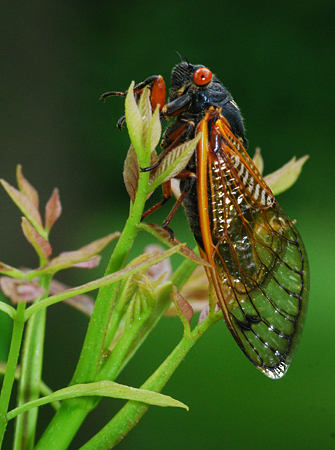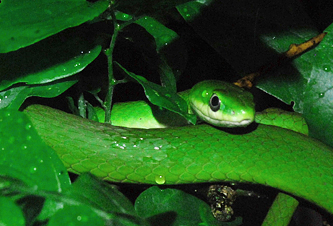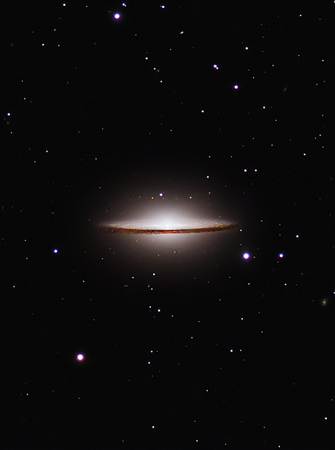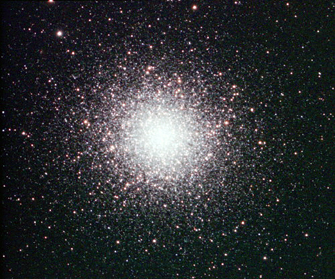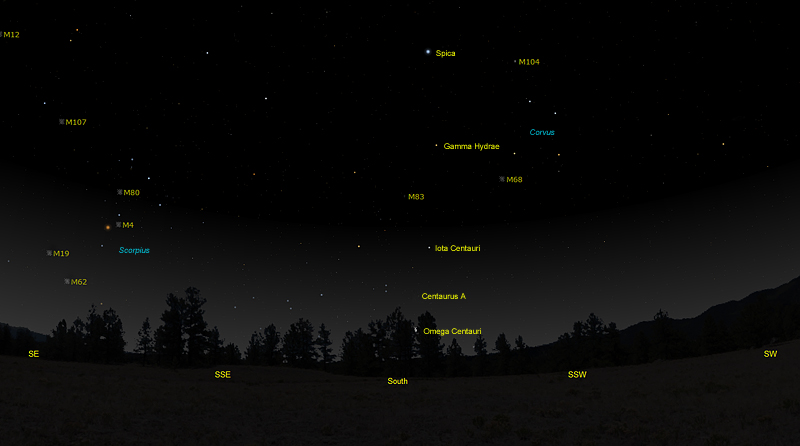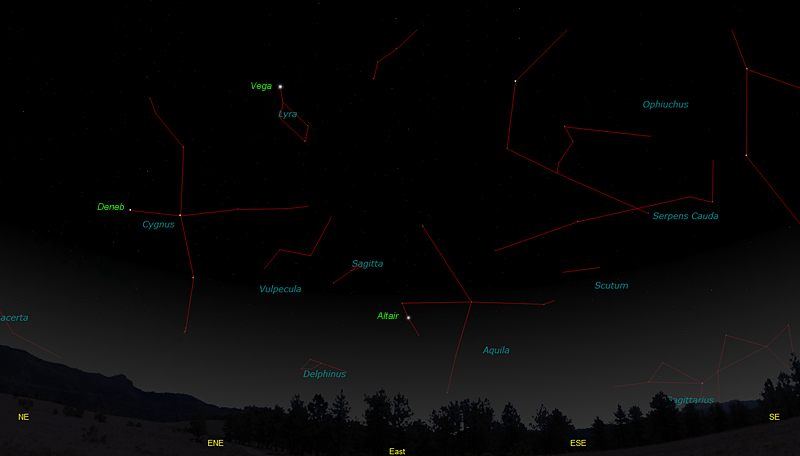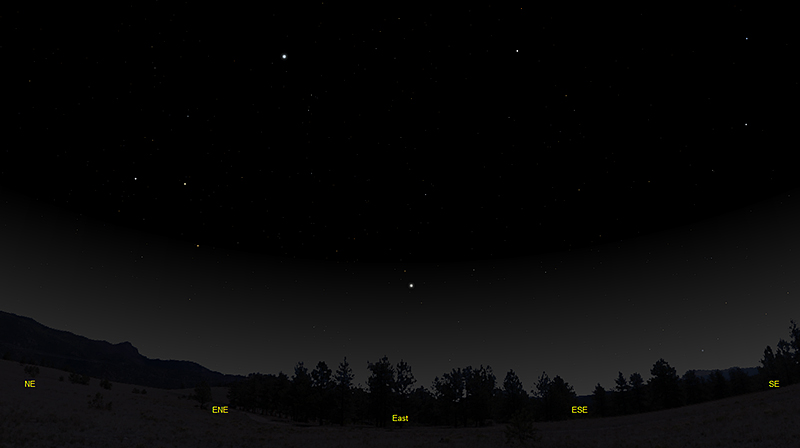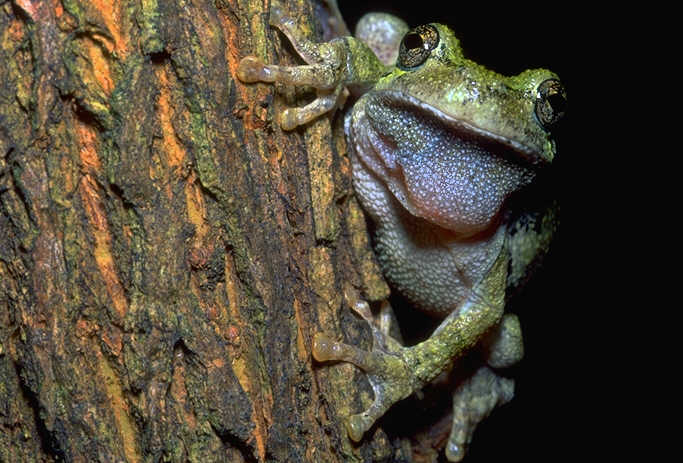The purpose of this feature is to give scout leaders, educators and naturalists an idea of some of the natural events coming up each month. We will try to cover a variety of natural events ranging from sky events to calling periods of amphibians, bird and mammal watching tips, prominent wildflowers and anything else that comes to mind. We will also note prominent constellations appearing over the eastern horizon at mid-evening each month for our area for those who would like to learn the constellations. If you have suggestions for other types of natural information you would like to see added to this calendar, let us know! Note: You can click on the hyperlinks to learn more about some of the featured items. To return to the Calendar, hit the "back" button on your browser, NOT the "back" button on the web page. All charts are available in a "printer friendly" mode, with black stars on a white background. Left clicking on each chart will take you to a printable black and white image. Please note that images on these pages are meant to be displayed at 100%. If your browser zooms into a higher magnification than that, the images may lose quality. Though we link book references to nationwide sources, we encourage you to support your local book store whenever possible. Notes and Images From May 2011
Last month, we talked of the
1998 emergence of
13-year cicadas
and
their predicted return this May. Well, return they did. After 13 years of
living in the soil, they came back with a vengeance, ready to slip
the surly bonds of Earth. We saw our first this year on May 7th. Each day
seems to bring more. They perch in the
morning sun atop high grass, bushes and small trees, ready to warm up and take
flight.
Periodical cicadas are grouped in "broods". All cicadas of the same life-cycle type emerging in a given year are considered a brood. Broods are numbered with Roman numerals. The cicadas we are seeing in this emergence belong to Brood XIX. Brood XIX is a 13-year periodical cicada, with a previous emergence in 1998 and the next emergence in 2024. This brood's range in Tennessee is shown on the accompanying map, and it actually occurs only in a third of Tennessee by area. The other 13-year brood we have in Tennessee is the Brood XXIII. It is mainly a west Tennessee brood and will emerge again in 2015. We also have two broods of 17-year cicadas, Brood X (next emergence 2021 in East Tennessee) and Brood XIV (next emergence 2025 in Middle and West Tennessee). There are four species of 13-year cicadas that belong to Brood XIX. All belong to the genus Magicicada. The three species that occur in Tennessee are Magicicada tredecassini, Magicicada tredecula and Magicicada tredecim. All look similar from above, but have varying patterns on their abdomen. The fourth species, Magicicada neotredecim, does not occur in Tennessee. All three of the Tennessee species can sometimes be heard calling together. The call of Magicicada tredecassini is a loud buzzzzzzz sometimes preceded by a few random clicks. The call of Magicicada tredecula is a series of evenly-spaced clicks that sounds like an old-fashioned lawn sprinkler. Finally, the rather wonderful call of Magicicada tredecim is a long, high note that descends suddenly at the end. It has been phonetically rendered as, "Phaaaaaaaaaaa-raoh", with the second syllable dropping about 5 notes in pitch. We made this recording along the Little Harpeth River in Williamson County on May 30th, 2011. In it you can hear all three species. Listen for the lawn sprinkler sound of the tredecula first, then listen for the prominent buzz of a cassini. While the "Phaaaaaaaaaaa-raoh" sound of the tredecim is present throughout, it's easier to hear at the end of the cut. A Tufted Titmouse and an Eastern Wood-Pewee can also be heard calling. Earphones will allow you to hear more. The adult cicadas only live a few weeks after emerging from their long stay underground. I, for one, do not begrudge them their time in the sun.
We came across this Rough Green Snake while walking the path to our barn one rainy night in early May. About five feet above the ground in a young Hackberry tree, its color blended perfectly with the young leaves. These beautiful snakes are quite beneficial, eating a diet primarily of insects and spiders. This makes them particularly susceptible to pesticides. The scales are "rough," having a weak keel, which can be seen in the image at right. Hence the common name. The scientific name is Opheodrys aestivus, which translates to "summer tree-snake".
In late April and early May we spent four nights imaging Messier 104, the Sombrero Galaxy. I still remember the thrill of seeing it visually for the first time in my homemade 6 inch reflector, and seeing the mysterious dark lane cut across the soft glow of the galaxy's core. It's a tough galaxy to image because it sits just above Corvus, the Crow and only gets a maximum of 42 degrees above the southern horizon. Because of its low altitude in the sky it took four nights to get the eight hours of exposure required for the image. A night-singing Yellow-breasted Chat kept us company at the scope on a couple of nights. In the high resolution version of the image some of the faint objects in the halo that appear star-like are actually globular clusters belonging to M104. These globular clusters have been studied in detail by the Hubble Space Telescope and provide a way to measure the limiting magnitude of the image at right, which is around visual magnitude 20.5. For more information on globular clusters in our Milky Way Galaxy see the "Summer Globular Clusters" section below. Though you need a clear moonless night to find it, M104 is relatively easy to find. There's a convenient group of stars just above Corvus that forms an "arrow" that points right to it. For more about the galaxy and a binocular finder chart click the image above. Messier 104 was discovered by Messier's friend Pierre Mechain on May 11th, 1781.
Sky Events for June 2011: The Sun is at the Summer Solstice at 12:16pm CDT on June 21st, marking the beginning of summer in the Northern Hemisphere, and the longest day of the year. Due to a number of factors the earliest sunrise occurs about 2 weeks before the solstice and the latest sunset occurs about two weeks after the solstice. Evening Sky: As June begins, Saturn is due south about 52 degrees above the horizon. This is a great time to see Saturn, and just about any small telescope will give a great view. Mercury can be seen quite low in the western sky after sunset during the last week in June. On June 30th it forms a straight line with Castor and Pollux of Gemini, with Mercury to the left of those stars. Look for it 30 to 45 minutes after sunset.
Summer Globular Clusters: This time of year is a great time to begin exploring the great globular clusters surrounding our Milky Way Galaxy. These spherical clusters of stars can measure over 100 light-years in diameter, and inhabit the halo around our galaxy (and other galaxies as well, see notes above on M104). Distances are in the 10's of thousands of light-years. In large telescopes they can be quite beautiful. In smaller telescopes you can usually resolve at least the outer stars in the cluster. Robert Burnham wrote in Burnham's Celestial Handbook about seeing the globular cluster Messier 5 in the Naval Observatory Station's 40 inch reflector at Flagstaff, Arizona:
At the beginning of June, Messier 13, shown in the above image, will be directly overhead at 12:52am. In binoculars, look for a small soft glow. In dark skies it can just be made out with the naked eye. For every date after June 1st, subtract 4 minutes per day from the time given. We enjoy picking out the some of the globular clusters of summer with binoculars or a small telescope on clear summer nights. One foray you can make with just binoculars is to explore the sky below the bright star Spica in early June. On June 1st, Spica is 42 degrees above the horizon and due south at 9:32pm. The sky will not be completely dark until about 9:45pm. The illustration below shows how your sky should look facing due south at that time. The main object of this search is the great globular cluster omega Centauri. Since it is only about 6 degrees above the horizon, you will need a very flat southern horizon. You will also need a clear night with little or no moon. This close to the horizon we are looking through about eight times as much atmosphere as when we look overhead, so we can only get a glimpse. It's important that Spica is close to due south when you look for the cluster, because omega centauri does not stay above the horizon for very long. On an extremely clear night you might be able to make it out with the naked eye, but you will probably want to find it with binoculars. Clicking on the chart above will take you to an ink-saving printable image with black stars on a white sky. To start out, mentally divide the sky below Spica into thirds. You should see gamma Hydrae about a third of the way to the horizon. You should see iota Centauri about two-thirds of the way to the horizon. These are both relatively bright stars, and good markers. Once you've found iota Centauri, mentally divide the distance to the horizon into three parts again. About two-thirds of the distance from iota to the horizon, look for omega Centauri. Alternately, you can just look at the horizon directly below Spica and then come up a little over one binocular field. The cluster will be a diffuse glow, and will look like a small tailless comet. To see this cluster overhead you would need to be standing almost at the tip of South America. If you are using binoculars, you may want to stop along the way and try to see Messier 83, a galaxy. Both of these objects are shown on the binocular finder chart for M104. If you're using a telescope, you may want to attempt to spot the great elliptical galaxy Centaurus A. Morning Sky: Venus is a brilliant point of light in the eastern dawn sky during June, but remains quite low to the horizon. Look for it about 30 minutes before sunrise. Mars rises before Venus and you can find the fainter planet above and to the right of Venus. On June 29th a thin crescent moon is halfway between the two planets, which should be a pretty sight. Jupiter rises about 3:27am at the beginning of the month and will be above and to the right of Mercury and Mars throughout the month. All times noted in the Sky Events are for Franklin, Tennessee and are Central Daylight Time. These times should be pretty close anywhere in the mid-state area. Constellations: The views below show the sky looking east at 10:00pm CDT on June 15th. The first view shows the sky with the constellation outlined and names depicted. Star and planet names are in green. Constellation names are in blue. The second view shows the same scene without labels. New constellations this month in the eastern sky are Lyra, the Lyre, with it's bright star Vega, Cygnus, the Swan, and Aquila, the Eagle. The bright stars Vega, Deneb and Altair form the "summer triangle."
On Learning the Constellations: We advise learning a few constellations each month, and then following them through the seasons. Once you associate a particular constellation coming over the eastern horizon at a certain time of year, you may start thinking about it like an old friend, looking forward to its arrival each season. The stars in the evening scene above, for instance, will always be in the same place relative to the horizon at the same time and date each June. Of course, the planets do move slowly through the constellations, but with practice you will learn to identify them from their appearance. In particular, learn the brightest stars (like Altair and Vega in the above scene looking east), for they will guide you to the fainter stars. Once you can locate the more prominent constellations, you can "branch out" to other constellations around them. It may take you a little while to get a sense of scale, to translate what you see on the computer screen or what you see on the page of a book to what you see in the sky. Look for patterns, like the stars that make up the constellation Lyra. The earth's rotation causes the constellations to appear to move across the sky just as the sun and the moon appear to do. If you go outside earlier than the time shown on the charts, the constellations will be lower to the eastern horizon. If you observe later, they will have climbed higher. As each season progresses, the earth's motion around the sun causes the constellations to appear a little farther towards the west each night for any given time of night. If you want to see where the constellations in the above figures will be on July 15th at 10:00pm CDT, you can stay up till 12:00am CDT on June 15th and get a preview. The westward motion of the constellations is equivalent to two hours per month. Recommended: Sky & Telescope's Pocket Star Atlas is beautiful, compact star atlas. It is destined to become a classic, and is a joy to use at the telescope. A good book to learn the constellations is Patterns in the Sky, by Hewitt-White. You may also want to check out at H. A. Rey's classic, The Stars, A New Way to See Them. For skywatching tips, an inexpensive good guide is Secrets of Stargazing, by Becky Ramotowski. A good general reference book on astronomy is the Peterson
Field Guide,
A Field Guide to the Stars and Planets, by Pasachoff. The book retails for around $14.00. Starry Night has several software programs for learning the night sky. Visit the Starry Night web site at www.starrynight.com for details.
Amphibians:
In June the treefrogs really hit their stride. Listen for Cope's Gray Treefrogs, Gray Treefrogs, Bird-Voiced Treefrogs, Green Treefrogs and Barking Treefrogs. Northern Cricket Frogs and Southern Cricket Frogs call a lot during June, and the calls of Bullfrogs, Green Frogs and Fowler's Toads fill the night air. After heavy rains listen for the high, insect-like call of the Eastern Narrowmouth Toad and the strange-sounding Eastern Spadefoot. Recommended: The Frogs and Toads of North America, Lang Elliott, Houghton Mifflin Co.
Birds: Now is a good time to get to know the breeding birds of Tennessee. It's fun to take a trip to the Great Smoky Mountains National Park in June and hike a high altitude trail, like the Alum Cave Bluff trail. By doing so you can encounter birds that breed in Tennessee at these higher elevations, like Black-throated Blue Warblers, Canada Warblers, Chestnut-sided Warblers and Blackburnian Warblers. Recommended: The Sibley Guide to Birds, David Allen Sibley The Sibley Guide to Birds of Eastern North America, David Allen Sibley An inexpensive guide for beginners is the Golden Guide for Birds.
Archives (Remember to use the back button on your browser, NOT the back button on the web page!) Natural Calendar February 2011 Natural Calendar December 2010 Natural Calendar November 2010 Natural Calendar September 2010 Natural Calendar February 2010 Natural Calendar December 2009 Natural Calendar November 2009 Natural Calendar September 2009 Natural Calendar February 2009 Natural Calendar December 2008 Natural Calendar November 2008 Natural Calendar September 2008 Natural Calendar February 2008 Natural Calendar December 2007 Natural Calendar November 2007 Natural Calendar September 2007 Natural Calendar February 2007 Natural Calendar December 2006 Natural Calendar November 2006 Natural Calendar September 2006 Natural Calendar February 2006
Natural Calendar
December 2005
Natural Calendar
November 2005
Natural Calendar
September 2005
Natural Calendar
February 2005
Natural Calendar
December 2004
Natural Calendar
November 2004
Natural Calendar
September 2004
Natural Calendar
February 2004
Natural Calendar
December 2003
Natural Calendar
November 2003
Natural Calendar
September 2003 Natural Calendar February 2003 Natural Calendar December 2002 Natural Calendar November 2002 Nature Notes Archives: Nature Notes was a page we published in 2001 and 2002 containing our observations about everything from the northern lights display of November 2001 to frog and salamander egg masses. * Adapted from University of Tennessee sources Night scenes prepared with The Sky 6 Professional from Software Bisque All images and recordings © 2011 Leaps |
||||||||||||

